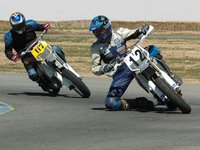(also called Supermotard due to its strong foothold in France) is a cross-over of motocross and road racing. Races are commonly held on road racing tracks with an off-road section in the infield; approximately 70% tarmac and 30% dirt. The motorcycles used are frequently custom-created combinations of off-road motorcycles and road-racing rims/tires. Riders also wear a combination of road race and offroad equipment, normally leathers and a motocross helmet and boots. Unlike normal motorcycle racing, the emphasis lies on slower (<100>


History:
Supermoto has its origins in the 1970s where ABC’s Wide World of Sports was the highest-rated sports show in the United States. In 1979, ABC commissioned a made-for-TV event to be included in the series, named Superbikers, whose intention was to find the ultimate all-around motorcycle racer. Superbikers was then manifested as a yearly event run at southern California's Carlsbad Raceway. The show's tarmac-and-dirt courses were intended to draw on talent from the worlds of off-road, flat-track and road-racing. World and National Championship-winning motorcycling greats such as Kenny Roberts and Jeff Ward, whose respective sports at the time were road-racing and motocross, participated in the races. The Superbikers quickly became a huge Nielsen rating contender, running until 1985, at which point ABC was forced to cancel the show due to new management and budget cuts; its cancellation also initiated a long sabbatical of the sport in the USA. The European racers who participated in the sport at Carlsbad, however, brought it back to Europe with them, where it quickly gained popularity in countries such as France.
2003 signalled the resurrection of the sport in the United States with the birth of the AMA Supermoto championship.




Machines:
Prior to the 1990s, supermotos, including the precursor motorcycles used in Superbikers, were converted open-class two-stroke motocross or enduro bikes. The motorcycles currently used for Supermotard racing are predominantly single-cylinder 4 stroke powered dirtbikes with 17" or 16.5" wheels. The smaller rims allow the use of up to 5.5" wide superbike road racing slicks and are often hand grooved on the rear tire to facilitate slightly better acceleration on the dirt stretches of a motard course. Suspension is lowered and slightly stiffened in comparison with a stock motocross bike, and braking power is improved with oversize rotors and calipers as well. Despite the lack of trees on supermoto courses, 'bark busters' (hand guards) are frequently added to supermoto bikes due the extreme cornering angles achieved by riders.



In 1991 Italian manufacturer Gilera released the 'Nordwest' model, the first factory produced supermoto. Other European manufactures quickly followed suit, among them KTM, Husqvarna, Husaberg AB and CCM Motorcycles; all manufacturers whose emphasis were off-road models at the time. Models were developed for both track and road use. It took another 10 years, until the mid 2000s for Japanese manufacturers, such as Yamaha (2004), Honda (2005) and Suzuki (2005) to start introducing supermoto models in the european market, emphasising more domesticated models for road use rather than outright racing. Dual-purpose motorcycles such as the Kawasaki KLR650 are good examples of this. In the spring of 2006, Italian bike manufacturer Ducati announced their entry in the class with the "Hypermotard" machine which has more in common with streetfighter-type motorcycles than realistically being considered a supermoto. KTM currently has available a 950 "V" twin that could be described as the ultimate road going supermoto. Aprilia also has two new (450 and 550) SXV v-twin supermotos for sale.

Due to the popularity and versatility of these motorcycles, some owners modify them for street usage. In order to do this, headlights, taillights, and street-legal tires among other occasional modifications are needed, while some, such as the Husqvarnas and newer KTMs, come street legal from the factory. These motorcycles make excellent city-goers as their upright seating position provides comfort and great visibility. Their narrow frames and light weight also make them incredibly manuverable, as well as easier to ride in less than ideal road conditions that make most sportbikes have to slow down.























2 Comments:
This comment has been removed by the author.
Bike Offroad Equipment refers to accessories and gear designed for offroad biking. Offroad equipment for biking includes items like specialized tires, suspension systems, protective gear, such as helmets and body armor, handlebar grips, offroad lights, and navigation tools suitable for trail riding. These are essential for enhancing the performance, safety, and comfort of offroad biking experiences.
https://www.horntools.com/
Post a Comment
Subscribe to Post Comments [Atom]
<< Home